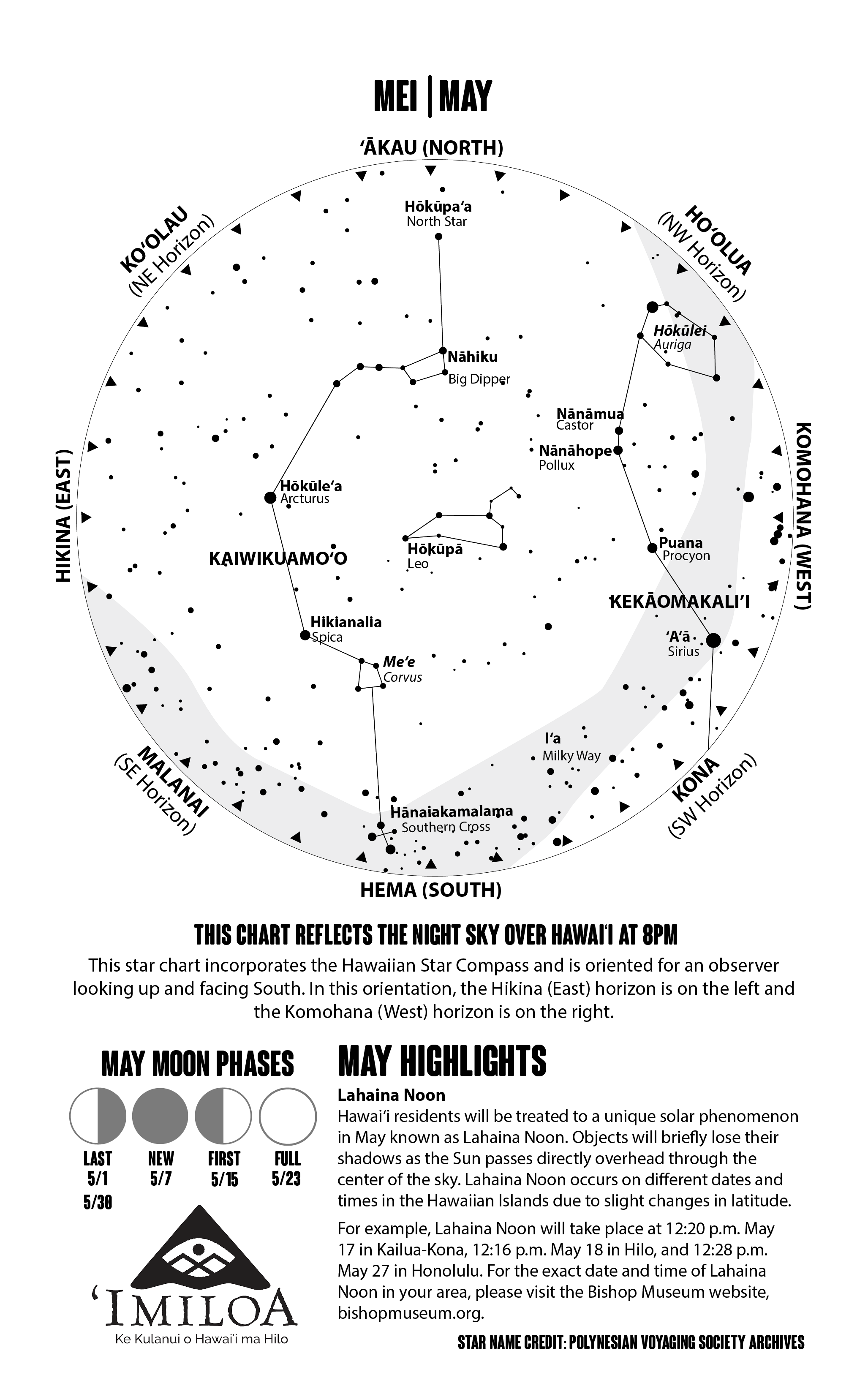May 2024 Sky Watch
May 2024 Sky Watch
by ‘Imiloa Astronomy Center
Maunakea Astronomy News
Astronomers using two observatories on Maunakea have found an ancient star system orbiting the Milky Way that is the faintest and lowest-mass satellite to our galaxy ever detected. It also may be one of the most dark matter-dominated systems known.
Discovered by the W.M. Keck Observatory and Canada-France-Hawaiʻi Telescope on Maunakea, as well as Pan-STARRS on Haleakalā, the satellite has been given two names — Ursa Major II and UNIONS 1 — because it has not yet been confirmed whether it’s a dwarf galaxy or a star cluster.
The satellite is a host to a mere 60 stars that are over 10 billion years old. In total, it spans just 10 light years across. That prompted researchers to ask how it could have stayed intact this long without being torn apart by the Milky Way’s tidal forces. According to Keck, one explanation is that dark matter may be keeping the stars grouped together.
“The fact that the system appears intact leads to two equally interesting possibilities,” Yale University graduate student Will Cerny said in a Keck press release. “Either UMa3/U1 is a tiny galaxy stabilized by large amounts of dark matter, or it’s a star cluster we’ve observed at a very special time before its imminent demise.”
According to Keck, conclusive evidence of the presence or lack of dark matter will be key to determining whether the star system is a dwarf galaxy or a star cluster. While its identity is ambiguous, the observatory states that its discovery could pave the way for new perspectives in cosmology.
Special Events
Lahaina Noon
While April’s solar eclipse barely clipped Hawaiʻi, residents will be treated to a unique solar phenomenon in May known as Lahaina Noon. Instead of the Sun disappearing behind the Moon, objects will briefly lose their shadows as the Sun passes directly overhead through the center of the sky.
Due to its proximity to the equator, Hawaiʻi experiences Lahaina Noon twice a year — once in May and once in July — in the months before and after the Summer Solstice.
Lahaina Noon, a term coined by the Bishop Museum, occurs on different dates and times in the Hawaiian Islands due to slight changes in latitude. For example, Lahaina Noon will take place at 12:20 p.m. May 17 in Kailua-Kona and 12:16 p.m. May 18 in Hilo, even though both towns are located on Hawaiʻi Island. In Honolulu, Lahaina Noon will occur at 12:28 p.m. May 27.
For the exact date and time of Lahaina Noon in your area, please visit the Bishop Museum website, bishopmuseum.org.
The exact moment of Lahaina noon, when the Sun is at the exact center of the sky, will only last a moment. At ʻImiloa, our mosaic “Voyage of the Navigator” is positioned exactly under our sky light so that during Lahaina noon the mosaic is perfectly illuminated by the sky light above.
Meteor Shower
The Eta Aquarid meteor shower, active from April 19-May 28, will peak from May 4-5 and is viewable during the pre-dawn hours. This meteor shower emerges in the direction of Aquarius and is named after one of the brightest stars in that constellation.
The Eta Aquarid is one of two meteor showers created by debris from Comet Halley. The other, the Orionid meteor shower, peaks around Oct. 20.
Evening Observing
Hānaiakamalama (the Southern Cross) returns to the evening sky just above the Southern horizon. Hānaiakamalama is a unique asterism. When upright, it points toward the South celestial pole. The best time to view Hānaiakamalama will be when it is standing straight up in the sky just after 9 p.m.
Hānaiakamalama is also the Southern tip of the navigational star family, Kaiwikuamoʻo (the backbone). This star family stretches from Hōkūpaʻa, the North star, through Nāhiku, the Big Dipper. It then follows the arc of Nāhiku to Hōkūleʻa and Hikianalia, then passing through Meʻe where it will then drop straight down to Hānaiakamalama.
Kaiwikuamoʻo is joined in the evening sky by Kekāomakaliʻi, visible toward the West. The great celestial bailer starts in the North with the hexagonal shape of Hōkūlei, a lei of stars, passes in a gentle arc through the stars Nānāmua and Nānāhope, then to Puana and the brightest star in the evening sky, ʻAʻā, before dropping down to to Kealiʻiokonaikalewa (below the horizon) to form the handle of the bailer.
Morning Observing
During the early morning hours, the planets Saturn (Makulu) and Mars (Hōkūʻula) will be rising from the Hikina (East) horizon. Through a very good pair of binoculars or a telescope, early morning observers can spot the famous rings of Saturn.
After 4:30 a.m. they will be followed by the planet Mercury (Ukali Aliʻi).
While the planets will stand out in the Eastern sky, the notable shape of Kamakaunuiamaui, Maui’s Fishhook, will be setting in the West. This recognizable shape of stars will be sitting in front of the “bulge” of the Milky Way where astronomers study the central regions of our galaxy.

